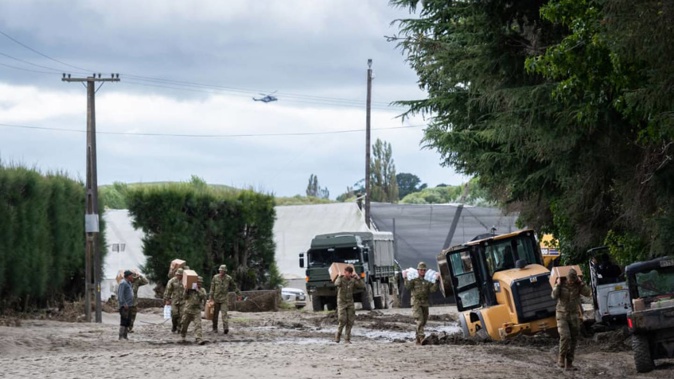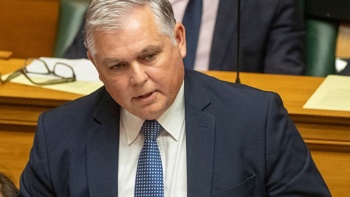
Charlotte Cook of RNZ
The New Zealand Defence Force (NZDF) couldn’t use its preferred options in response to Cyclone Gabrielle because of ongoing critical staff shortages.
When asked by the government to act, it had to change the size of its response and the capabilities it could offer.
It has also been forced to pay all personnel up to $10,000 each to keep them in their jobs so they do not have to shut down more parts of the navy, air force and army.
The NZDF has now made two separate rounds of payments in a bid to keep people in their roles and “stem the flow of people leaving”.
There are not enough personnel to run three naval offshore patrol vessels, and the Air Force P-3K2 Orions were put into retirement five months early because of the shortage of trained staff.
Three ships are also tied up at Devonport unable to be used because of the lack of staff to run them.
The NZDF said the high attrition rate over the past two years has meant it had lost key personnel with highly specialised and sought after skills that take years to develop, leaving the force with crucial gaps.
NZDF Chief of Defence Force Air Marshal Kevin Short said plumbers, electricians, carpenters, Special Forces, Navy propulsion experts and middle managers are just some of the most critical trades within the forces.
While he hoped the payments might lure people into staying, Short said it could take up to four years to train people to replace those key roles.
- Kieran McAnulty warns people to take Cyclone Gabrielle seriously, despite downgrade
- Cyclone Gabrielle: Coromandel Civil Defence focus on getting fuel to farmers and isolated communities
- Cyclone Gabrielle: Sun out in Coromandel but job not done, says Civil Defence
- Hawke's Bay Civil Defence boss was on leave for tramping trip when cyclone hit
“A lot of cases, it’ll take almost up to a decade to get those same skill levels back again.”
Reduced options during Cyclone Gabrielle
The high level of people quitting is not only impacting the basic functions of the army but it is also hurting its capacity to respond in an emergency, like Cyclone Gabrielle.
The NZDF said it was able to meet the needs for a short domestic civil defence response like the Auckland floods and the cyclone. Had there been another major event it might not have been so easy.
“Another major event at the same time would have meant the NZDF would have faced difficult decisions on appropriate response options,” a spokesperson said.
Short said more than 1000 personnel were deployed at the time, but they had to make choices about how, who and what they did in response to manage the parts of the services that were no longer in operation.
NZDF said “high attrition rates meant that the response itself had to be adjusted, such as personnel deploying for longer duty periods”.
Because some ships and planes could not be crewed, lesser options (or less fit for purpose options) were used instead.
“A good example would be the East Coast surveillance conducted after Cyclone Gabrielle by a C-130H Hercules aircraft.
“This would have likely been conducted by the P-3K2 Orions if those aircraft had not been withdrawn from service five months earlier than planned because of attrition in the Air Force.
“In addition, an Offshore Patrol Vessel would have more likely been deployed to Napier instead of the frigate HMNZS Te Mana as it would have been considered a more suitable vessel, but none were available as the two OPVs [Offshore Patrol Vessel] are in care and custody at Devonport.”
Short said while he hoped the payments would put a stop to the people jumping ship, if the attrition rate continues the NZDF would have to look at capabilities it would be unable to operate.
He also said the NZDF was currently operating at a lesser standard than he would like, and not a position he expected to be in.
Payments to reduce attrition rate
In February the NZDF used $10 million of government funding to make one off payments of $10,000 to people in “strategically significant” uniformed trades and units which had been heavily affected by resignations.
That ‘retention payment’ was applied across the three services: Army, Navy and Airforce.
The money is being paid in two tranches. The first was in February, the second lot of $5000 will be paid in May.
Short said this round of payments was tackling trades such as plumbing and special forces where there were depleting numbers.
He said they focused on several units where they were losing people at a higher rate than expected and were dealing with a number of resignations.
Short said they expected the first round of payments would reduce the number of people leaving. It did not.
Amid an accelerating rate of attrition, by late March 2023, the NZDF decided to expand the initiative to all regular force personnel and civilians.
Short said the numerous vacancies had saved a lot of money in personnel salaries and costs - and the surplus from the last financial year would go towards retention payments.
In May, Regular Forces, civilian members, and civilians working at offshore locations would get a one-off payment of $3661.
It was also decided to increase allowances for maritime and land personnel by $75 per day for personnel at sea, and $50 per day for personnel in the field, on top of what they already receive while the figures are permanently reviewed.
It will also make targeted payments to “critical areas of the army” from “strategically fragile trades”.
Short said those targeted payments would be in addition to the $3661 depending on their rank and role, and the most someone could get was $10,000.
The NZDF said the March initiative was about five per cent of the annual personnel budget at about $50 to $60m.
Short said the remuneration relates to what people would be earning outside the NZDF, and they were targeting areas where further resignations would shut down parts of the organisation.
He admitted topping up staff with extra cash was not a long-term solution, and the NZDF would work on salaries and staff costs with the government.
“Not all of it is about pay, we need to look at other conditions of service to look after our people as well,” Short said.
The attrition rate
The NZDF said the attrition rate is high across all three services and the civilian staff base.
At the end of February, it was sitting at 15.6 per cent for the regular force.
It was 17 per cent for the navy, 16.7 per cent for the army and 12.4 per cent for the air force. Civilian staff attrition was running at 15.4 per cent.
It said those figures do not show the seriousness of the now dire situation.
Across the last two years the regular force has lost 29.8 per cent of its full time, uniformed, trained and experienced staff. This number excludes soldiers who have served less than two years.
Without this cash injection, or intervention, it was projecting that the overall attrition rate was expected to reach 32.6 per cent by the end of June.
Take your Radio, Podcasts and Music with you









